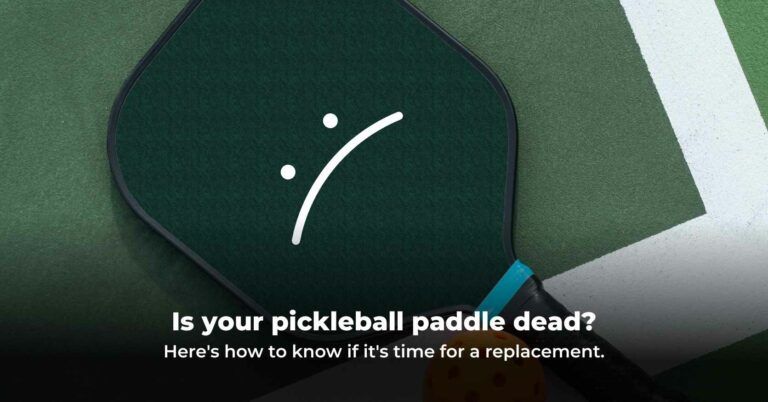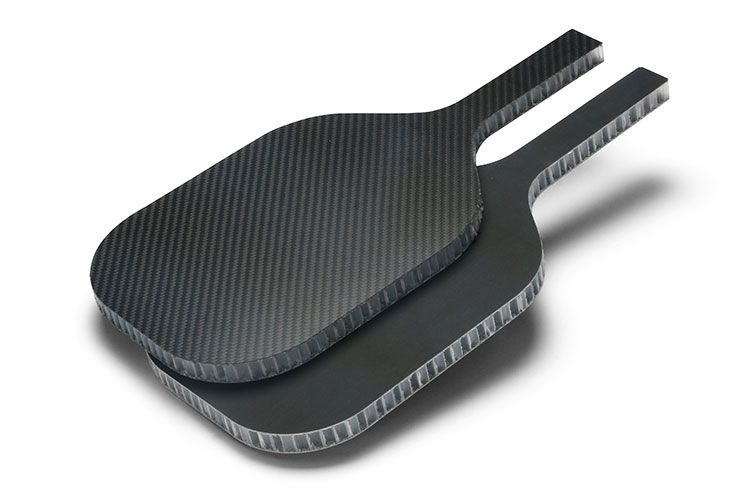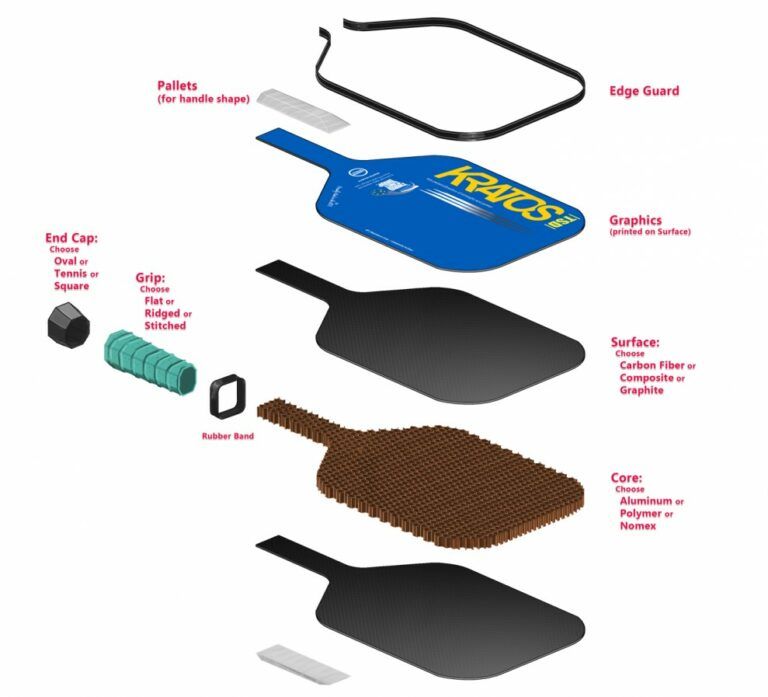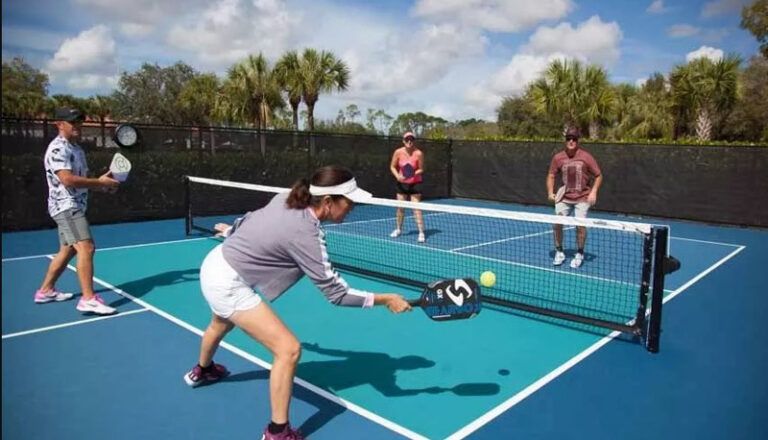How long do Pickleball paddles last?
The pickleball paddle longevity is not a one-size-fits-all answer. Various factors intertwine to influence how long your paddle will perform at its peak. The intricacies of paddle materials, the frequency of play, your unique playing style, and how well you maintain your equipment all contribute to its lifespan. Understanding these components helps players predict when it might be time for an upgrade.

What impacts how long a paddle lasts?
- Material Quality: The composition of your paddle plays a crucial role in its durability. High-quality options like composite or graphite paddles tend to outlast their wooden counterparts. Wooden paddles, while often more budget-friendly, usually offer a shorter lifespan, particularly under heavy usage.
- Frequency of Use: Another significant factor is how often you engage in play. Casual players may experience a paddle lifespan extending up to three years, while competitive players regularly find themselves replacing paddles every six months to a year due to the more intense demands of the game.
- Playing Conditions: Environmental factors like the surface of the court matter too. Paddles used on harder outdoor surfaces might show more wear compared to those played on indoor courts. The materials in outdoor courts can chip and wear down paddles more quickly, which is a consideration when choosing where to practice.
- Care and Maintenance: Proper maintenance can significantly enhance a paddle's lifespan. Adequate care, such as avoiding extreme temperatures and storing paddles correctly, helps keep them functioning longer. Regular check-ups and prompt repairs can mitigate long-term damage, allowing you to extend the utility of your favorite paddle.
By understanding these elements, players can anticipate paddle longevity and strategize their investments accordingly, ensuring that the thrill of the game endures as long as possible without interruptions.
Decoding pickleball paddle materials
The construction of a pickleball paddle fundamentally determines its performance and lifespan. Two key components focus on are the paddle core and the paddle face, each offering unique benefits and potential drawbacks.
The core: the heart of your paddle
Different materials construct the core of a pickleball paddle, impacting durability and playability. The three most common core materials include:
- Polymer Core: Renowned for its balanced blend of durability and weight, this is the most popular choice among players of all levels. It provides a soft feel and excellent power, making it suitable for recreational and competitive play.
- Nomex Core: Considered a premium option, Nomex offers superior durability and sound performance. Many competitive players prefer this material for its ability to maintain responsive touch.
- Aluminum Core: Known for its sturdiness, aluminum holds up well over time but can feel heavier in hand compared to polymer or Nomex.

The face: where the magic happens
When it comes to the paddle face, various materials each with its benefits can influence performance markedly. Here’s how the major contenders stack up:
- Graphite Face: Arguably the most coveted in the market, graphite provides excellent power and control thanks to its lightweight properties and ability to generate strong spin. Players using graphite paddles often report a better feel due to their responsiveness.
- Fiberglass Face: Slightly heavier than graphite, fiberglass paddles are typically more affordable and can deliver a good combination of power and control. They might be best suited for beginners or recreational players looking for value.
- Carbon Fiber Face: An emerging favorite, carbon fiber blends the benefits of both graphite and fiberglass, providing a unique play experience. Known for its durability and broad sweet spot, carbon fiber faces are gaining traction among advanced players.

Ultimately, understanding these materials helps players match their paddles to their preferences while maximizing both performance and durability.
Your playing style and paddle longevity
Your unique playing style and frequency can have a tremendous impact on how long your paddle will last. The way you approach each game plays a pivotal role in assessing paddle durability.
How often do you play?

The correlation between your frequency of play and paddle lifespan can be illustrated well. Consider the following:
- Recreational Player: Someone who plays a couple of times a week, perhaps around five to ten hours total, may experience a paddle lifespan of two to three years with proper care.
- Competitive Player: On the other hand, a player who participates in daily practice sessions or tournaments can easily rack up over twenty hours of play each week. In this case, replacing a paddle every six months becomes the norm, as continuous pressure and extended use lead to quicker wear.
Are you a power player or a finesse player?
Your playing style offers insight into paddle longevity as well. Aggressive players, who employ dynamic shots and hit the ball with force, place more strain on their paddles. Comparatively, finesse players, relying more on delicate control and precision, may see their paddles last longer.
Where do you play?
Lastly, consider the playing surface. Indoor games tend to exert less wear on the paddle compared to outdoor courts. Additionally, playing on rough or uneven surfaces contributes further wear and tear. Opting for quality over quantity in your playing conditions can, therefore, extend your paddle's utility.
Maximizing your paddle's performance and lifespan
Once you're committed to your paddle, extending its lifespan and maximizing its performance should become top priorities. Simple care routines can lead to significant longevity while improving your overall game.
Clean it like you mean it
Regular maintenance is key. A thorough cleaning routine is essential. After every game, wipe down your paddle to avoid the buildup of dirt, moisture, and any harmful debris. Additionally, consider performing detailed monthly cleanings using mild soap and water. Avoid harsh chemicals, as they may damage the paddle’s surface and weaken its durability over time.
Storage matters: treat your paddle right
Proper storage plays a critical role in maintaining paddle longevity. Always store paddles in a cool and dry environment, avoiding extreme temperatures that can warp the materials. Investing in a paddle cover is recommended, as it shields against inadvertent damage from bumps and drops.
Gear up for protection
Utilizing protective gear further extends the paddle's lifespan. Obtaining edge guards can safeguard the edges from chipping and serious damage, while using grip tape helps maintain hygiene and improve performance with each shot. Be proactive in your paddle care, and you’ll reap the benefits of longevity and consistent performance.
The telltale signs: is your paddle on its last legs?
Recognizing the subtle indicators that your paddle is nearing the end of its life is crucial for maintaining optimal gameplay. Changes in visual appearance and performance can signal that it might be time for a replacement.
Look for the visual clues
Regular inspection can help you catch damage early. Look for obvious signs like:
- Paddle Cracks: Inspect for cracks on the face or edge. Even small cracks can impact performance over time.
- Paddle Chips and Dents: Surface imperfections can drastically affect how the ball interacts with the paddle.
- Smooth Paddle Face: If your paddle’s surface feels smooth and lacks texture, it’s losing its ability to impart spin effectively.
- Loose Edge Guard: This might indicate that your paddle has sustained knock or damage.
Listen carefully: sound can be a giveaway
In addition to visual signs, listen attentively to the sound your paddle makes during play. If you begin to hear a hollow sound or rattling, it might indicate internal damage or core crushing. These auditory cues signal that your paddle could be nearing the end of its lifespan.
Feel the difference: performance tells the story
A decline in performance is often the clearest indicator. If you experience a significant loss of power, find that there are 'dead spots' when hitting, or feel an inconsistent response when striking the ball, it’s likely time for a new paddle. Quality gameplay demands quality gear, and a well-maintained paddle serves as the lifeblood of your success on the court.
Delamination and core crushing: the silent killers
Understanding the hidden threats to your paddle longevity is just as important as recognizing visual and auditory cues. Two significant issues delamination and core crushing can affect your paddle performance in subtle yet concerning ways.
What are they, and why should you care?
- Delamination: This occurs when layers within the paddle begin to separate, affecting not only durability but performance. A delaminated paddle loses its coherent feel, leading to inconsistencies in power and control.
- Core Crushing: This happens when damage occurs internally, often caused by an accident on the court. A crushed core diminishes the paddle’s responsiveness and results in a less enjoyable playing experience.
Spotting the culprits: how to identify these issues
Watch for signs of delamination, like a noticeable gap between layers or texture loss on the paddle surface. To check for core crushing, hold the paddle and apply gentle pressure. A significant loss of structural integrity will yield a loose, unresponsive feel when you strike the ball.
Time to say goodbye: why replacement is essential
Ignoring these signs not only reduces performance; it can also lead to injuries during play. A damaged paddle impacts shot quality and reduces your overall enjoyment of the game. For both safety and performance, you should replace the paddle once you notice these serious issues.
Warranty: your paddle's safety net
A warranty can serve as an invaluable safety net, offering protection for your investment. Understanding the terms and claiming benefits can provide significant peace of mind.
What's covered, and for how long?
Different manufacturers offer varied warranty periods. Most paddles feature warranties spanning 6 months to a few years, covering defects in materials and workmanship. Familiarize yourself with specific exclusions that might affect your coverage.
Making a claim: getting a new paddle
To make a claim, ensure you register your warranty and keep proof of purchase. Familiarizing yourself with the manufacturer's claims process will streamline the replacement of your paddle without unnecessary headaches.
Repair, replace, or credit: what are your options?
Depending on the policy, you may have various options when it's time for replacement repair or credit towards a new purchase. Understanding these alternatives puts you in a strong position when making paddle decisions.
Choosing your next weapon: finding the right replacement paddle
When it comes time to choose your next paddle, taking an analytical approach will pay dividends in the long run.
Know thyself: what kind of player are you?
Consider factors such as your playing style, skill level, and budget. If you play aggressively, investing in a higher-end, durable paddle may save money over time. On the flip side, less intense players may be well-served by mid-range options.
Feature focus: matching features to your game
Identify which features matter most whether that’s power, control, spin, or grip size. Knowing what you need from your paddle ensures that your next purchase aligns perfectly with your playing style.
Paddle picks: recommendations for every player
Consider seeking reviews and comparisons of paddles to help narrow down your choices. Websites dedicated to pickleball equipment can provide extensive insights into every paddle’s pros and cons. Think of this as another opportunity to invest thoughtfully in your game.
Play smart, play long: extending your paddle's life
Ultimately, extending your paddle's life starts with your day-to-day habits, including cleaning, maintenance, and even how you play.
Level up your care routine
Adopt an advanced care routine that goes beyond basic cleaning incorporate routines that capitalize on enhancing performance while keeping longevity in mind. Utilize best practices like appropriate paddle covers and routine inspections.
Pick a paddle built to last
Selecting a paddle constructed from robust materials ensures your investment stands the test of time. Durable paddles offer resilience and performance that will enhance your gameplay over the long haul.
Breaking bad habits: what not to do
Avoiding damage should be at the top of your list. Poor practices, such as hitting walls or neglecting maintenance, can lead to premature paddle wear. Prioritize thoughtful and respectful play to avoid damaging your gear.
Sustainability: playing responsibly
In today’s world, embracing sustainability in sports is crucial. Consider how your paddle choices affect the environment throughout its lifespan and beyond.
The problem with paddle waste
As paddles reach the end of their lives, paddle disposal can contribute to significant waste. Understanding your options for responsible disposal can reflect a commitment to reducing your environmental impact.
Eco-conscious options for the future
Look for paddles made from recycled materials or brands committed to sustainable practices. Many manufacturers now focus on eco-friendly materials, offering players a chance to be environmentally conscious while enjoying their sport.
Playing your part: what you can do
Extending paddle lifespan through responsible care, thoughtful purchasing, and proper disposal makes a real difference. By supporting sustainable brands, you contribute not only to your game but also to the future of the planet.
In conclusion, understanding how long pickleball paddles typically last is essential for anyone passionate about the sport. By keeping a close eye on factors such as material quality, usage, and care, you can ensure that your paddle serves you well across many games. Recognizing the signs that your paddle may need to be replaced will not only enhance your performance on the court but can also save you from potential disappointments. Taking responsible steps toward paddle maintenance can lead to a rewarding experience, allowing you to focus on what truly matters: enjoying the game.










